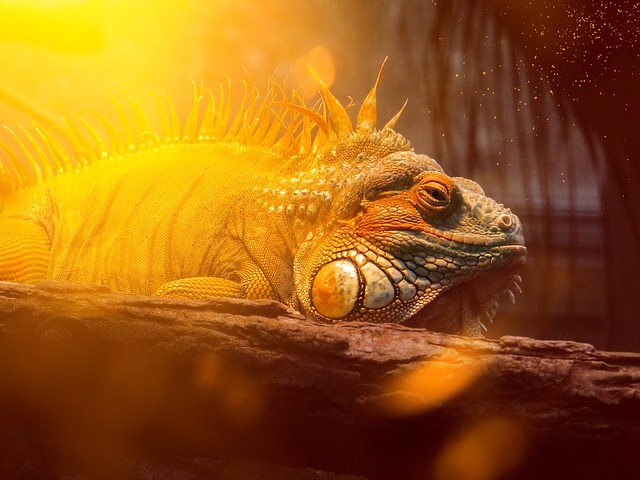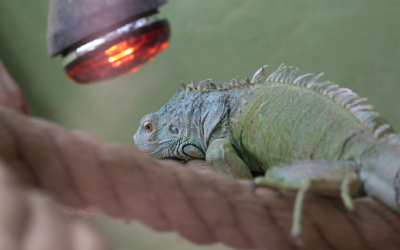Heating and Lighting – Heating and lighting the iguanaís enclosure are two problems that many people choose to solve at the same time. Incandescent (regular bulbs that screw into regular light sockets) spotlights, available from your hardware or lighting store in a wide variety of wattages, can keep your iguana’s cage both warm and bright. This is my heating method of choice. By placing a spot light at one end of the cage, you can create a nice temperature gradient for your iguana, which is essential to its well being. The area directly under the light would be the basking spot, where your iguana will go to warm up early in the day. The basking spot should be in the mid-nineties. (Degrees Fahrenheit.) You might want to invest in an aquarium thermometer so that you may test the temperature at all parts of the cage. As the iguana gets farther away from the basking spot, the ambient temperature decreases.

The coolest part of the cage should be around 80 degrees. As a general rule, iguanas need to maintain an internal temperature of 88 degrees for about 10 hours a day if effective digestion is to take place. My favorite way to mount the spot light is to screw it into a shop-light fixture, and set it right on the screen or wire top of the cage. Lights should never be placed inside the cage because iguanas will climb on them and burn themselves. If you do not have a screen or wire top to your cage, you could shine the light through a screen or wire side. (Some part of the cage must usually be screen or wire, or else there will not be enough ventilation! See Ventilation section.) If your cage has no screen or wire sides but still has effective ventilation, you could place a light bulb or ceramic heat emitter (which screws into a regular light bulb socket but emits no light) in the cage, but make sure to put wire or screen around it. You must use a thermometer, however, to make sure the inside of the cage is at the correct temperature.
There are also under tank heaters made to be placed under aquariums to warm the floor, which is suitable for young specimens that spend much of their time sitting on the floor of their cages. They are not very effective at warming up the air temperature inside aquariums so if you have an iguana that spends its time on branches or rocks that do not come into contact with the floor of the aquarium, an under tank heater will not do you much good. If you do invest in a floor heater, human heating pads are much less expensive and easier to control than the ones marketed for reptiles in pet stores. In addition, I recommend against using “hot rocks”, as they are notorious for over-heating and burning reptiles on their ventral sides. Also, wild iguanas obtain their heat from the sun above, not rocks below. Hot rocks are kind of neat ideas in themselves in that the manufacturers have given you a mini heater in the shape of a rock, which might seem perfect for a reptile cage. But remember – the rock is just a heater, and in the author’s experience, an unstable one at that. All of my hot rocks have “burned out” and are now useless except for decoration – probably because it is impossible to keep them from getting wet. I know several other people whose hot rocks have overheated, thus resulting in burns on their iguanas. In conclusion, the only really suitable methods I have found for heating iguana enclosures has been incandescent spot lights and regular space or room heaters. If you use a heater, make sure that the iguana cannot come into contact with it and knock it over or burn itself. Iguanas seem to be the happiest when they have a basking spot, so you may use a space heater to help heat the iguanaís area, but the iguana should really have a basking spot as well.

Vegetable matter contains a large amount of cellulose (which is the main component of plant cell walls) which most animals cannot digest on their own. Iguanas have microorganisms living in their hindgut which break down the cellulose for them. These microorganisms need hot temperatures in order to do their work, so if you keep your iguana too cool, one of the effects will be poor digestion, which will lead to problems stemming from malnutrition.
